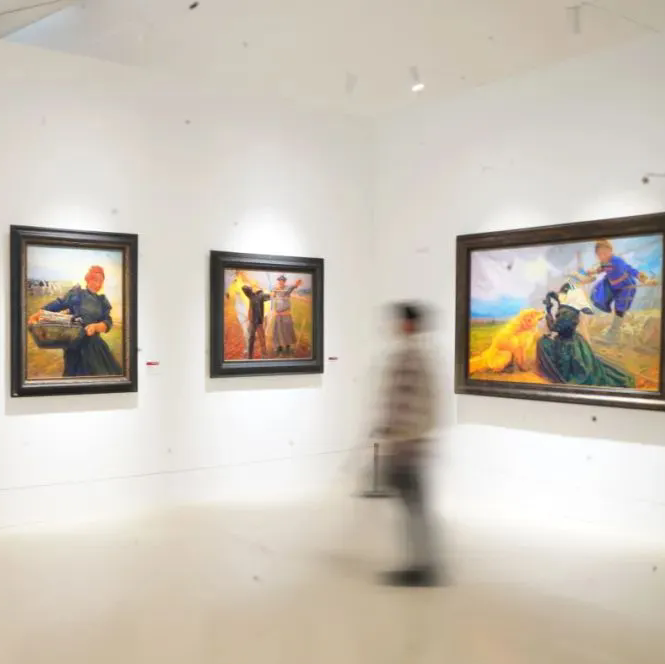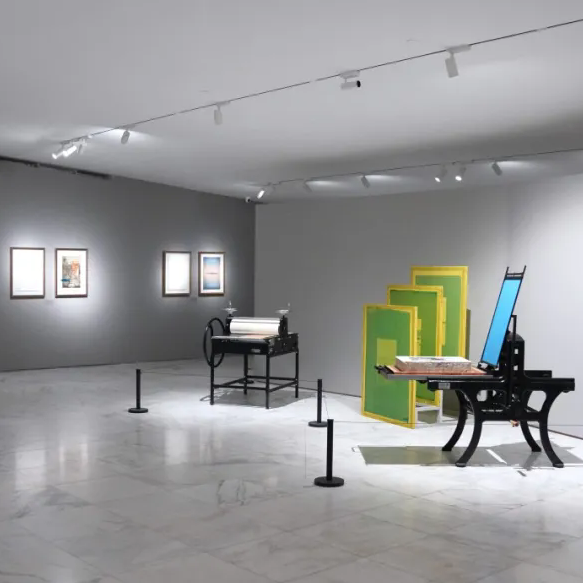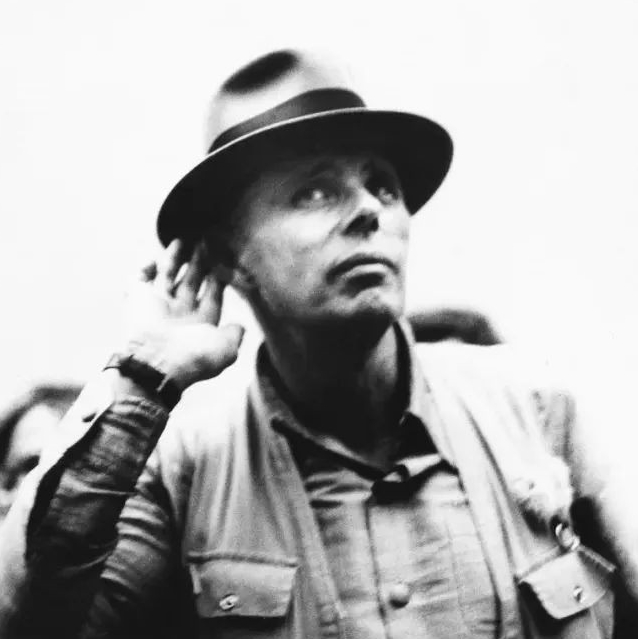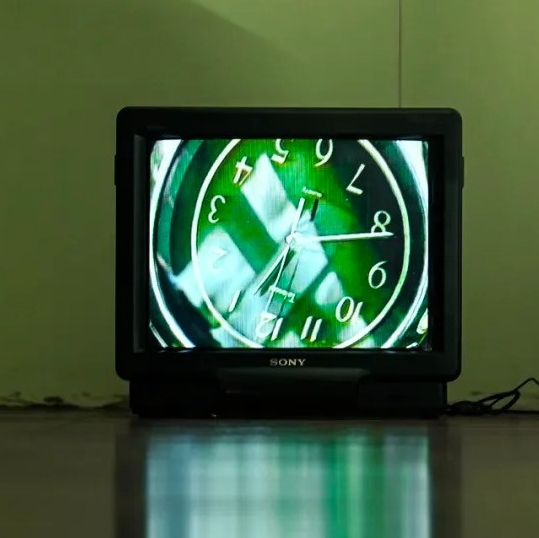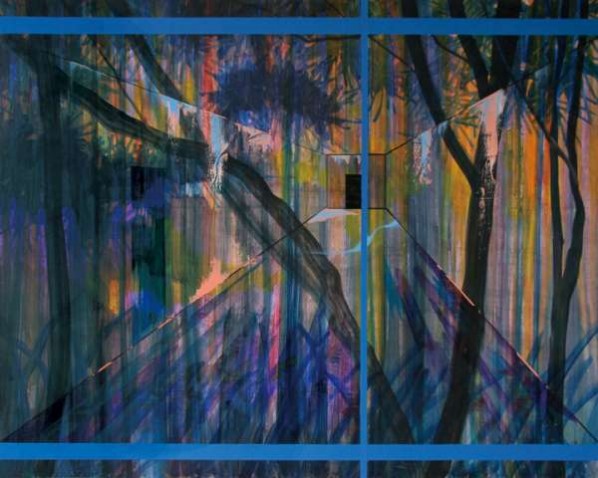
Red Gate Gallery is pleased to announce an exhibition of Jiang Weitao’s latest abstraction work titled Gap. Over the last few years Jiang has perfected his highly glossed oil on canvases which project a very subtle layering of patterns under a varnished surface. There is warmth and a delicacy to each of his colored abstractions - the viewer is drawn to the work seeking meaning in the patterns, only to find a certain calmness in the painter’s considered brushwork. Taking his practice further in this exhibition, Jiang crosses over to sheen-less works on paper and shining ceramics which reinforce the character of his palette.
[gallery link="file" orderby="title"]
The Harmonic Abstraction of Jiang Weitao by Tally Beck
Jiang Weitao asserts his commitment to abstraction and describes his natural arrival at it within the context of traditional Chinese arts. In his introduction, he discusses the philosophical link between Chinese calligraphy, painting and poetry. This trinity of expression, known as san jue, or the ‘three perfect things,’ is a concept acknowledged by contemporary art historians as one of the keys to understanding Chinese artists’ approach to abstraction. Jiang states that these three art forms “inherited the same spirit,” and that “[they] all intend to represent complexity with simplicity, concrete with abstract.”
The writings of contemporary Chinese art historian Wen Fong substantiate Jiang’s explanation of this uniquely Chinese approach to abstraction: “Because the key to Chinese painting is calligraphic brushwork, the integrity and cohesion of Chinese art theory and the practice of calligraphy are based not on the priority of either representation or nonrepresentation but on the essential harmony between the two.”1 Jiang is clear to state that his interest does not lie in “conforming to the surface of form,” but rather in harmonies between “the spirit and context of an individual, stillness and movement, forward and reverse…” His attention to this harmony reflects Daoist principles, which often emerge in theoretical assessments of modern and contemporary Chinese abstraction.
Whereas twentieth-century Western abstraction completely rejected representation in favour of pure formalism, Chinese artists resist being so doctrinaire. The influential American art critic Clement Greenberg almost single-handedly established draconian approaches to abstraction as he championed the Abstract Expressionists in the 1950s. For Greenberg (and, as a result, for an entire generation of painters in the mid-twentieth century), painting could not have any connection to the forms of the real world. Painters such as Jackson Pollack and Mark Rothko embodied these notions in their two-dimensional, insistently nonrepresentational canvases. The formal elements of line and color were emphasized, and these aspects became the subject matter itself.
Jiang, like many Chinese artists, is more interested in creating a harmony between his abstract world and the natural world. In his Art Documents, he demonstrates his unique reconciliation of formal elements as an expression of balance. What makes his work outstanding and engaging is his successful combination of this reconciliation with a painterly atmosphere of dynamism and vibrancy.
Many of his compositions are dominated by an emphatic horizontality or verticality. With this salient characteristic, we may be prompted to recall Piet Mondrian and his commitment to the resolution of these two visual opposites, but Jiang’s vision does not conform to Mondrianesque rigidity. Instead, Jiang’s linear construction is organic and gestural and imbued with energy. His forms sometimes resemble bamboo segments, scales, and lozenge-like forms, but nothing recognisable emerges.
Longer examination and consideration by the viewer will reveal underlying patterns. Here, again, we can appreciate the intricate construction of his canvases. What he achieves is not a dizzying optical effect, but a subtle, relaxed emergence of another visual layer beneath the glossy surface mosaic of flowing fragments.
The geometric tension of his frameworks is dissipated by the softness of intervening forms and by the gentle bath of delicate color blends surrounding jewel tones. Jiang is a master colourist in the tradition of Henri Matisse. His saturated palette and handling of gradations are an emotional journey in their own right.
The harmony that Jiang strives for resonates in his compositions. While he deliberately avoids representation, we can still find evidence of organic forms in his works. This incorporation attaches his abstraction to our world. In that sense, it is very different from the nonrepresentational, subjective experiments of Western abstraction. The painter Wu Guanzhong summed up this difference with a charming analogy in reference to his own abstract tendencies: “I believe that non-objective art is like a kite with a broken string. The string that connects the kite to life has been severed; that which links it to emotion and to the karma of the world is broken off….I shall always prefer my kite to a kite with a broken string.” The emotion and karma Wu speaks of are alive and well in Art Documents, and they place Jiang firmly in the tradition of the great Chinese abstractionists.
About the Exhibition
Duration: June 16, 2012 - July 15, 2012
Veune: Red Gate Gallery, Levels 1 & 4, Dongbianmen Watchtower, Dongcheng, Beijing
Curator: Brian Wallace
Tel/ Fax: (86 10) 6525 1005
Gallery Hours: 9 am - 5 pm Everyday
Courtesy of the artist and Red Gate Gallery, for further information please visit www.redgategallery.com.


